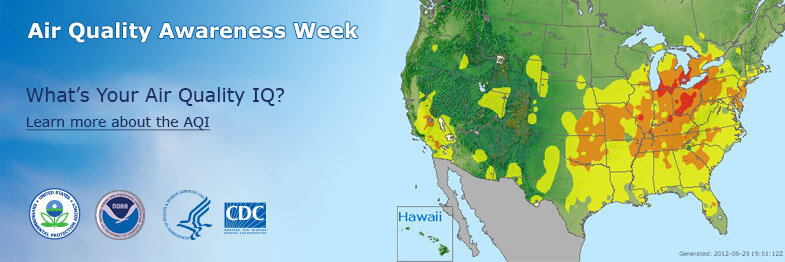It’s Air Quality Awareness Week
Every spring, during Air Quality Awareness Week, the Environmental Protection Agency (EPA) partners with federal agencies such as the National Weather Service, the Centers for Disease Control and Prevention (CDC), and the U.S. Department of Energy to raise awareness about efforts to protect and improve air quality, highlight available resources, and encourage people to incorporate air quality knowledge into their daily lives. The theme of this year’s campaign, which is May 1 through 5, is “Working Together for Clean Air.”
According to the CDC, the two major threats to air quality are ground-level ozone and particle pollution, which can especially affect people with lung disease such as asthma and other health conditions.
Ground-level ozone (pollutants emitted by cars, power plants, industrial boilers, refineries, chemical plants, etc.) has been linked to:
- Coughing and pain when taking a deep breath
- Lung and throat irritation
- Wheezing and trouble breathing during exercise or outdoor activities
Particle pollution can be harmful to your health and comes from several sources, including wood stoves, forest fires, power plants, cars, trucks, and construction sites.
- They can irritate the eyes, nose, and throat
- Fine (smaller) particles are more dangerous because they can get into deep parts of your lungs, or even into your blood
Ground-level ozone and particle pollution can affect anyone, but those at higher risk include:
- People with lung diseases, such as asthma, bronchitis, or emphysema
- Older adults
- People of all ages who exercise or work hard outside
- Babies and children
NYCHA’s Environmental Health and Safety Department (EHS) would like to share the following ways you can protect yourself and your family from the harms of ground-level ozone and particle pollution, as well as the triggers associated with asthma.
How to protect yourself from ground-level ozone and particle pollution:

You can monitor air quality by checking the Air Quality Index (AQI), which can be heard on radio and TV weather reports or found online. The AQI is a tool that tells you when high levels of air pollution, including ground-level ozone and particle pollution, are expected. Try checking it when you’re planning your daily activities.
The CDC recommends the following when the AQI is not optimal:
- Think about spending more time indoors, where ozone levels are usually lower
- Choose easier outdoor activities (like walking instead of running) so you don’t breathe as hard
- Plan outdoor activities at times when ozone levels are lower (usually in the morning and evening)
- Avoid busy roads and highways where particle pollution is usually worse because of emissions from cars and trucks
Also, be aware of common asthma triggers:
- Tobacco smoke – Unhealthy for everyone, especially people with asthma. If you have asthma and you smoke, quit smoking. “Secondhand smoke” is smoke created by a smoker and breathed in by a second person. Secondhand smoke can trigger an asthma attack.
- Dust mites – Microscopic bugs that are in many homes. If you have asthma and are allergic to dust mites, they can trigger an asthma attack.
- Outdoor air pollution – Can trigger an asthma attack and can come from many sources, including factories, cars, or wildfire smoke.
- Pests – Cockroaches and other pests are often found where food is eaten and crumbs are left behind.
- Mold – Can trigger an asthma attack whether or not you are allergic to mold. Indoor mold growth is often found in damp areas such as kitchens, bathrooms, and basements, or in areas where water damage has occurred.
- Cleaning and disinfection products – People with asthma should try to stay away when cleaners or disinfectants are being used and right after their use.
If you have questions about this or any environmental health and safety matter, please email ehs@nycha.nyc.gov.
For additional information on air quality and asthma, please visit:

